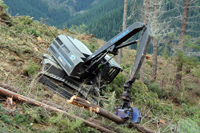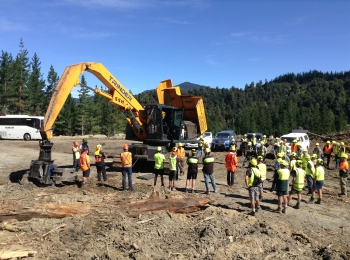The challenge
 Developing a machine to make harvesting safer and cheaper.
Developing a machine to make harvesting safer and cheaper.
The New Zealand forestry sector and the Ministry for Primary Industries have both identified steep-country harvesting as a key bottleneck to achieving greater profitability in forestry. Worker safety is also an issue. Future Forests Research (FFR) has formed an alliance of research providers, forest owners, and tree harvest engineering and machinery companies to deliver a programme that could extend commercial forestry establishment on steep marginal land.
The solution
The programme aims to:
- reduce steepland harvesting costs by 25 percent
- grow harvest machinery manufacture in New Zealand to future-proof the sector
- make harvesting jobs safer.
The centrepiece of this programme is the development of a steep-slope, feller–buncher machine which can operate safely and efficiently on steep slopes without endangering workers.
The ClimbMAX, as this ground-based harvester is called, is being built by Kelly Logging and Trinder Engineers in Nelson. The machine is now in commercial production and is successfully harvesting trees on slopes of up to 40 degrees.
In addition to the ClimbMAX, the programme is developing new systems, including remote controlled machinery, advanced hauler vision, grapple control and innovative yarding technology to improve the productivity and safety of cable harvesting systems.
 The ClimbMAX machine being inspected at a Future Forest Research field day in Maungataniwha forest near Napier on 22 March 2014, which was attended by around 55 forestry contractors and company representatives. Four ClimbMAX machines are now in commercial use – 3 in New Zealand and one in Canada. A fifth machine is under construction.
The ClimbMAX machine being inspected at a Future Forest Research field day in Maungataniwha forest near Napier on 22 March 2014, which was attended by around 55 forestry contractors and company representatives. Four ClimbMAX machines are now in commercial use – 3 in New Zealand and one in Canada. A fifth machine is under construction.
Outcome Logic Model
Outcome logic for Steepland Harvesting PGP Programme
Outcomes to date
- Development of the ClimbMax harvester, a new ground-based harvesting machine which can fell and bunch logs on steep slopes and remove the need for chainsaw operator has been completed. Four machines have been built and are now in commercial operation – three in New Zealand and one in Canada. A fifth machine is under construction.
- In initial trials, the ClimbMax machine has shown an increase in the volume of logs cut and bunched ready for extraction of 65 tonnes per unit per day (a 26% increase in productivity) and a net cost saving of approximately $3.50 per tonne (10%) over conventional harvesting methods (a direct cost saving of $8m per annum within 5 years). Worker safety is also improved by removing the need for manual labour on the ground on steep slopes.
- Development of the Advanced Hauler Vision system to improve productivity of cable harvesting and improve worker safety is now completed. This system involves cameras mounted to grapple carriages and ground-based high resolution video cameras to improve the hauler operator's vision of the harvesting site. The first grapple-mounted camera unit was sold in 2012. The "Cutover-Cam" hauler vision system is now also in commercial production and the first unit has been sold.
- Improvements to the Alpine Grapple carriage have been completed and this product is now commercially available. The Alpine is a lightweight, lower cost option than conventional motorised grapples which improves the efficiency and utility of grapple systems for NZ logging conditions. Five units have been sold and a further three are on order.
- Development of the HarvestNav on-board navigation system is now completed and this product is available free of charge to the forest industry. It provides machine operators with information on harvest area terrain around the machine, improving machine operation and safety. Twenty-six licences have been issued for its use; seven have been installed and are operational.
- Successful installation and initial testing of the teleoperation control system to a harvesting machine for remote control of tree felling. This is believed to be a world first.
- Completion of design of the Innovative Yarding System, incorporating innovative carriage designs and a low cost yarder.
- An independent review of the programme was completed in November – download the summary report .
Research into other new innovations to improve productivity and safety of hauler technology and operational efficiencies is in progress.
Audit
Key facts
Programme start : November 2010
Length : 6 years
PGP funding : $3 million
Industry funding : $3 million
Crown funding paid out to programme for work done to 31 May 2016: $3,033,441.26
Commercial partners : Future Forest Research Ltd
Estimated potential economic benefits to NZ: $100 million per year by 2025.
Progress review summary report
Programme progress review – summary report